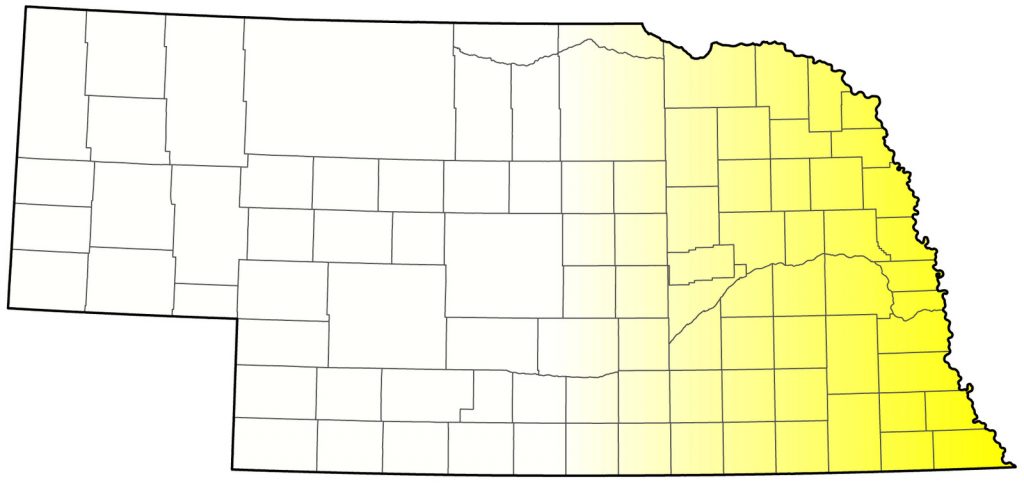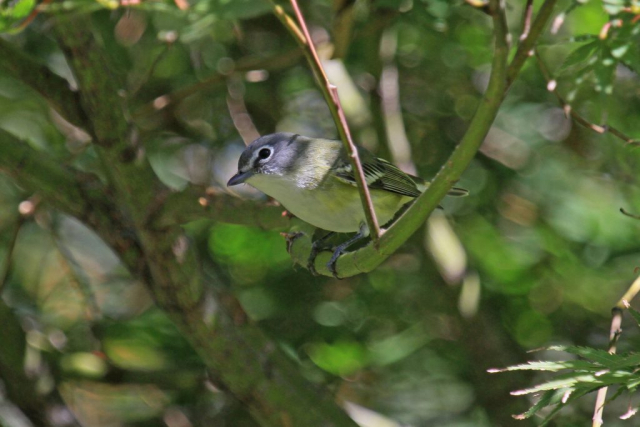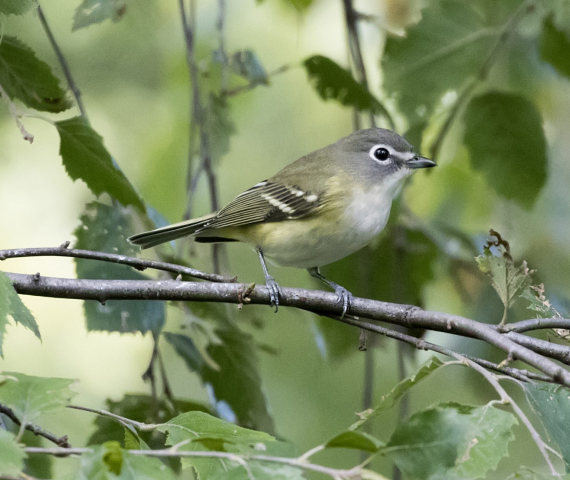Vireo solitarius solitarius
Status: Uncommon regular spring migrant east, rare east-central, rare casual west-central, accidental west. Uncommon regular fall migrant east, rare east central, rare casual west central and west.

Documentation: Specimen: UNSM ZM6767, 13 May 1917 Lancaster Co.
Taxonomy: Two subspecies are recognized (AviList 2025): solitarius from Canada through the north-central and northeastern USA, and alticola, of the southern Appalachian Mountains.
Nebraska birds are solitarius.
Spring: Apr 27, 27, 27 <<<>>> May 30, 31, Jun 1
A later date is 4 Jun 2025 Cass Co.
Blue-headed Vireo occurs with some regularity albeit rarely as a migrant west to Hall Co (Lingle 1994) and Buffalo Co in the Platte River Valley and Knox Co in the northeast. There is a single Panhandle record, one photographed in Sowbelly Canyon, Sioux Co 13 May 2017, and one in the west central, in Hitchcock Co 4 May 2025. A westerly report of “Solitary” Vireo 18 May 1986 in Keith Co (Rosche 1994; Brown and Brown 2001) may have been any of the three “new” species, although most likely a Blue-headed.
A specimen taken at Kearney, Buffalo Co 10 May 1914 is #2708 in the Brooking Collection (Brooking, Notes).
- High counts: 23 in Sarpy Co 11 May 1996 and 18 in Sarpy Co 13 May 1995.
Fall: Aug 20, 21, 21 <<<>>> Oct 17, 18, 19
An earlier date is 9 Aug 2018 Dodge Co.
Later dates are 23 Oct 2018 Lancaster Co, 23 Oct 2019 Douglas Co, 23 Oct 2020 Douglas Co, 24 Oct 1977 Garden Co, 28 Oct 1997 Douglas-Sarpy Cos, 29 Oct 2008 Sarpy Co, 29 Oct 2022 Lancaster Co, 30 Oct 1977 Crescent Lake NWR, Garden Co, 1 Nov 1987 Lancaster Co, 1 Nov 2021 Lincoln, Lancaster Co, 31 Oct-2 Nov 2024 Omaha, Douglas Co, and a banded Hatch Year bird 2 Nov 2000 Bellevue, Sarpy Co.
Migrants pass through the east between late Aug and mid-Oct but may linger rather late in fall.
Occurrence in fall is more widespread than in spring; occurrence is regular west in the central Platte River Valley to Buffalo and Harlan Cos. There are several Panhandle records: 29 Aug 2009 Wind Springs Ranch, Sioux Co, 30 Aug 2003 Oliver Reservoir, Kimball Co, 2 Sep 2018 Kimball Co, 3 Sep 2017 banded Chadron SP, Dawes Co, 6 Sep 2003 Carter Canyon, Scotts Bluff Co, 9 Sep 2009 banded at Chadron SP, Dawes Co, 11 Sep 2021 Garden Co, 16 Sep 2011 Hatch Year bird banded at Wildcat Hills NC, Scotts Bluff Co, 16 Sep 2006 Crescent Lake NWR, Garden Co, 20 Sep 2000 Wind Springs Ranch (Jorgensen 2002), 27 Sep 1998 photographed at Gering, Scotts Bluff Co (Brogie 1999), and 10 Sep-30 Oct 1977 Cresent Lake NWR. Most of the few documented records on the eastern Colorado plains are in Oct (Andrews and Righter 1992).
- High counts: 15 at Wilderness Park, Lancaster Co 12 Sep 2020, 8 at Ta-Ha-Zouka Park, Madison Co 10 Sep 2020, 6 at Wehrspann Lake, Sarpy Co 20 Sep 1999, 5 at Fontanelle Forest, Sarpy Co 27 Sep 2008, 5 in Lincoln, Lancaster Co 9 Sep 2021, 5 there 2 Sep 2024, and 5 in Douglas Co 6 Sep 2024.
Images
Abbreviations
NC: Nature Center
NWR: National Wildlife Refuge
SP: State Park
UNSM: University of Nebraska State Museum
Literature Cited
Andrews, R., and R. Righter. 1992. Colorado birds. Denver Museum of Natural History, Denver, Colorado, USA.
AviList Core Team, 2025. AviList: The Global Avian Checklist, v2025. https://doi.org/10.2173/avilist.v2025.
Brogie, M.A. 1999. 1998 (Tenth) Report of the NOU Records Committee. NBR 67: 141-152.
Brooking, A.M. Notes. Bird specimen records. Manuscript in NOU Archives, University of Nebraska State Museum, Lincoln, Nebraska, USA.
Brown, C.R., and M.B. Brown. 2001. Birds of the Cedar Point Biological Station. Occasional Papers of the Cedar Point Biological Station, No. 1.
Jorgensen, J.G. 2002. 2002 (sic; =2000). (12th) Report of the NOU Records Committee. NBR 70: 84-90.
Lingle, G.R. 1994. Birding Crane River: Nebraska’s Platte. Harrier Publishing, Grand Island, Nebraska, USA.
Rosche, R.C. 1994. Birds of the Lake McConaughy area and the North Platte River valley, Nebraska. Published by the author, Chadron, Nebraska, USA.
Recommended Citation
Silcock, W.R., and J.G. Jorgensen. 2025. Blue-headed Vireo (Vireo solitarius). In Birds of Nebraska — Online. www.BirdsofNebraska.org
Birds of Nebraska – Online
Updated 26 Aug 2025


